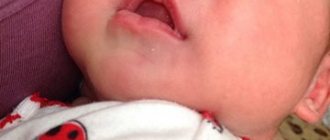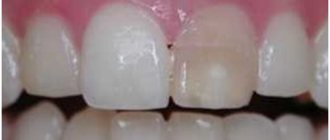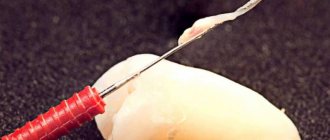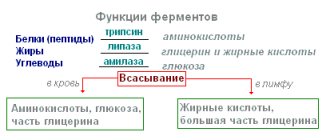The nerves of the eye are usually divided into three groups: motor, secretory and sensory.
Sensory nerves are responsible for regulating metabolic processes and also provide protection, warning of any external influences. For example, a foreign body entering the eye or an inflammatory process occurring inside the eye.
The task of the motor nerves is to ensure movement of the eyeball through coordinated tension of the motor muscles of the eye. They are responsible for the functioning of the dilator and sphincter of the pupil, and regulate the width of the palpebral fissure. The motor muscles of the eye, in their work to ensure the depth and volume of vision, are under the control of the oculomotor, abducens and trochlear nerves. The width of the palpebral fissure is controlled by the facial nerve.
The muscles of the pupil itself are controlled by nerve fibers in the autonomic nervous system.
Secretory fibers located in the facial nerve regulate the functions of the lacrimal gland of the organ of vision.
Innervation of the eyeball
All nerves involved in the functioning of the eye originate in groups of nerve cells localized in the brain and nerve ganglia. The task of the nervous system of the eye is to regulate muscle function, ensure sensitivity of the eyeball, and the auxiliary apparatus of the eye. In addition, it regulates metabolic reactions and blood vessel tone.
The innervation of the eye involves 5 pairs of 12 available cranial nerves: oculomotor, facial, trigeminal, as well as abducens and trochlear.
The oculomotor nerve originates from nerve cells in the brain and has a close connection with the nerve cells of the abducens and trochlear nerves, as well as the auditory and facial nerves. In addition, there is its connection with the spinal cord, providing a coordinated reaction of the eyes, torso and head in response to auditory and visual stimuli or changes in the position of the torso.
The oculomotor nerve enters the orbit through the opening of the superior orbital fissure. Its role is to raise the upper eyelid, ensuring the work of the internal, superior, inferior rectus muscles, as well as the inferior oblique muscle. Also, the oculomotor nerve includes branches that regulate the activity of the ciliary muscle and the work of the pupillary sphincter.
Together with the oculomotor nerve, 2 more nerves enter the orbit through the opening of the superior orbital fissure: the trochlear nerve and the abducens nerve. Their task is to innervate, respectively, the superior oblique and external rectus muscles.
The facial nerve contains motor nerve fibers, as well as branches that regulate the activity of the lacrimal gland. It regulates the facial movements of the facial muscles and the work of the orbicularis oculi muscle.
The function of the trigeminal nerve is mixed; it regulates muscle function, is responsible for sensitivity and includes autonomic nerve fibers. In accordance with its name, the trigeminal nerve splits into three large branches.
The first main branch of the trigeminal nerve is the ophthalmic nerve. Passing into the orbit through the opening of the superior orbital fissure, the optic nerve gives rise to three main nerves: nasociliary, frontal and lacrimal.
The nasolacrimal nerve passes through the muscular funnel, in turn dividing into ethmoidal (anterior and posterior), long ciliary, and nasal branches. It also gives off a connecting branch to the ciliary ganglion.
The ethmoidal nerves are involved in providing sensitivity to cells in the ethmoidal labyrinth, the nasal cavity, and the skin of the tip of the nose and its wings.
The long ciliary nerves lie in the sclera in the area of the optic nerve. Then their path continues in the supravascular space in the direction of the anterior segment of the eye, where they and the short ciliary nerves extending from the ciliary ganglion create a nerve plexus around the circumference of the cornea and the ciliary body. This nerve plexus regulates metabolic processes and provides sensitivity to the anterior segment of the eye. Also, the long ciliary nerves include sympathetic nerve fibers that branch from the nerve plexus belonging to the internal carotid artery. They regulate the activity of the pupillary dilator.
The short ciliary nerves begin in the region of the ciliary ganglion; they run through the sclera, surrounding the optic nerve. Their role is to ensure nervous regulation of the choroid. The ciliary ganglion, also called the ciliary ganglion, is a union of nerve cells that take part in the sensory (via the nasociliary root), motor (via the oculomotor root), and also the autonomic (via sympathetic nerve fibers) direct innervation of the eye. The ciliary ganglion is localized at a distance of 7 mm posterior to the eyeball below the external rectus muscle, in contact with the optic nerve. At the same time, the ciliary nerves jointly regulate the activity of the pupillary sphincter and dilator, providing special sensitivity to the cornea, iris, and ciliary body. They maintain the tone of blood vessels and regulate metabolic processes. The subtrochlear nerve is considered the last branch of the nasociliary nerve; it is involved in the sensitive innervation of the skin of the root of the nose, as well as the inner corner of the eyelids, part of the conjunctiva of the eye.
Entering the orbit, the frontal nerve splits into two branches: the supraorbital nerve and the supratrochlear nerve. These nerves provide sensitivity to the skin of the forehead and the middle zone of the upper eyelid.
The lacrimal nerve, at the entrance to the orbit, splits into two branches - upper and lower. At the same time, the upper branch is responsible for the nervous regulation of the lacrimal gland, as well as the sensitivity of the conjunctiva. At the same time, it provides innervation to the skin of the outer corner of the eye, covering the area of the upper eyelid. The inferior branch unites with the zygomaticotemporal nerve, a branch of the zygomatic nerve, and provides sensation to the skin of the cheekbone.
The second branch becomes the maxillary nerve and is divided into two main lines - the infraorbital and zygomatic. They innervate the auxiliary organs of the eye: the middle of the lower eyelid, the lower half of the lacrimal sac, the upper half of the lacrimal duct, the skin of the forehead and zygomatic region.
The last, third branch, having separated from the trigeminal nerve, does not take part in the innervation of the eye.
Anatomical structure
Infraorbital nerve: anatomy
The infraorbital (or inferior orbital) nerve is the main branch of nerve fibers arising from the maxillary nerve, which follows from the ending of the trigeminal nerve.
The latter is the largest pair (fifth in a row) of cranial nerves. A branch of the trigeminal nerve emerges from the posterior part of the brain through the foramen rotundum in the sphenoid cranial bone.
In the temple area, the nerve roots unite into the trigeminal ganglion, which diverges into three branches:
- ophthalmic;
- mandibular;
- maxillary.
The optic nerve distributes nerve endings to the skin of the forehead, cheekbones, nose, and parts of the eyeballs. The mandibular nerve branch goes to the masticatory and other muscles of the oral cavity, the inner surface of the cheeks and lips.
The maxillary branch, running through the pterygopalatine fossa (slit-like space in the lateral part of the skull), branches into three continuations:
- zygomatic nerve;
- nodal nerve branches;
- infraorbital nerve.
Through the infraorbital fissure, the infraorbital nerve enters the orbital cavity, continues along the infraorbital groove and through the infraorbital canal, and behind it, the infraorbital fissure enters the canine fossa, located in the anterior facial part of the skull.
The size of the infraorbital nerve varies from person to person. With brachycephaly (small height of the skull relative to its width), the trunk can reach 27 mm. With dolichocephaly (the reverse ratio of brachycephaly), the length of the nerve trunk is up to 32 mm.
Along its entire length, the infraorbital nerve gives off several branches, which diverge into main and scattered types. The main type of discharge is characterized by the presence of a main trunk and several large nerves extending from it. The nerves that emerge from the scattered type are small, there are many of them, and they have many connections.
The infraorbital nerve diverges into:
- Superior alveolar branches. They are divided into front, rear and middle. These branches intertwine with the alveolar vessels and run along the upper jaw, uniting into the upper dental plexus.
- Nasal branches – internal and external.
- Upper labial branches.
- Lower branches of the eyelids.
The infraorbital nerve and its branches are closely intertwined with the processes of the facial nerve, forming a single network of nerve endings that determine the mobility and sensitivity of the facial muscles.
Extraoral access
Extraoral anesthesia of the inferior alveolar nerve is carried out by three main methods: submandibular, subzygomatic and retromandibular.
With the submandibular method of anesthesia, the syringe needle is inserted into the skin under the inner surface of the lower edge of the jaw at a distance of 1.5 cm from the angle. The needle moves along the bone at the level of the posterior edge of the branch by 3.5-4 cm. The anesthetic depot of 1 ml created in this way helps to block the inferior alveolar nerve. Blocking the buccal and lingual nerves is achieved by moving the needle an additional 1 cm forward while adding 1 ml of anesthetic. The needle is moved 4 cm in the direction from the lower edge of the jaw, and an anesthetic solution is injected into the tissue at the same time. Additional movement of the needle to the area of the lingual and buccal nerves is due to the need to anesthetize the intervention zone of the three nerve areas.
This method of pain relief is also applicable if the patient’s neck is shorter than usual. The syringe is attached to the needle after it is injected at the level of the mandibular foramen. The thing is that the syringe itself creates a barrier to the movement of the needle to the bone level.
The subzygomatic approach, or Bershe Dubov approach, is characterized by inserting a needle into the skin. The injector is inserted at an angle of 90 degrees to its surface under the lower edge of the zygomatic arch, and a couple of centimeters from the base of the tragus of the auricle. Advancing the needle no deeper than 3-3.5 cm allows you to reach the inner surface of the marginal pterygoid muscle. Two mm of anesthetic substance in this case will be enough. Blocking of the lower alveolar, lingual and buccal nerves occurs after 10 minutes, and complete elimination of the contracture of the lower jaw is observed a little earlier.
The last option for extraoral anesthesia of the inferior alveolar nerve is a puncture of the gland located behind the ears. With this method of access to the site of dental interventions, there is a risk of touching the carotid artery, or even a branch of the facial nerve. Hence the rarity of its use, but it still exists as an anesthesia option.
Functions of the infraorbital nerve
The infraorbital nerve performs important functions.
The structure and location of the network of nerve endings and branches of the infraorbital nerve determines the functions it performs.
Each small branch is involved in providing nerve endings to a separate area of the human face.
All teeth in the upper jaw are supplied (innervated) by branches of the infraorbital trunk: large molars - with the help of the posterior upper alveolar branches, small teeth - with the help of the middle branches, incisors and canines - with the help of the anterior branches.
The upper gingival and dental branches depart from the upper alveolar nerve trunks, which innervate the teeth. The anterior superior alveolar branches are partially involved in the innervation of the nasal mucosa, and the posterior ones - the mucous membrane of the maxillary cavity.
The remaining branches of the infraorbital nerve supply the corresponding parts of the face with nerve endings:
- Skin of the nose - external nasal branches.
- Nasal mucosa - internal nasal branches.
- The skin of the lower eyelid - the lower branches of the eyelids.
- The skin and mucous membrane of the upper lip - the upper labial branches.
The infraorbital nerve, unlike the trigeminal nerve, has only sensory roots. Thus, the innervation of the teeth of the upper jaw, skin and mucous membrane of the mouth, nose allows a person to feel changes in temperature and humidity, touching these surfaces, and partly the relative relative position of individual parts of the face.
Where is the trigeminal nerve located?
|
|
The photo below shows where the trigeminal nerve is located in humans and its exit points in great detail.











